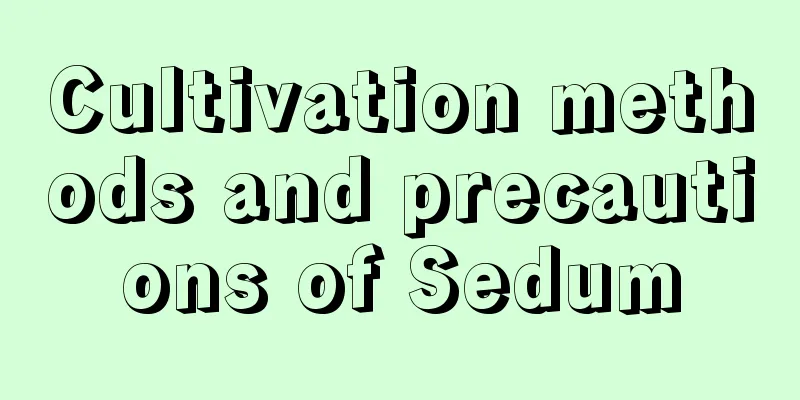Cultivation methods and precautions of Sedum

1. Maintenance methods1. Substrate selection: Sedum can grow better in loose, well-drained soil. We can mix it with leaf mold, garden soil and some clean river sand. 2. Light management: Place the plant in a ventilated and shaded place in summer and in direct sunlight in spring and autumn. In winter, it should be placed in a bright place indoors and provided with light all year round. 3. Nutrient management: The growth rate is relatively fast, so do not apply too much fertilizer. Otherwise, the sedum tree will become too lush and affect the tree shape and the beauty of the plant. During the growing season, it is enough to use two applications of diluted fertilizer water. Fertilization is prohibited in winter. 4. Water management: It has strong drought resistance and can grow even in drought conditions. However, its roots are afraid of waterlogging, and if water accumulates, it will cause root rot. The principle of watering it is not to water it when the soil is not dry, and when watering, make sure the soil is watered thoroughly. 2. Breeding techniques1. Wintering: Move it to a well-lit location in winter and wrap it with plastic film outdoors to keep it warm. However, the plastic film should be removed at noon every two days to allow the plants to ventilate, which is beneficial to their growth. 2. Summer: Place it in a cool place, provide it with shade, and spray it appropriately, 2 to 3 times a day. 3. Problem diagnosis and treatment1. Root rot: If you water too much, the accumulated water will harm the growth of its root system. You must control the frequency and amount of watering. 2. Leaf spot: If leaf spot is found, the diseased leaves can be removed to prevent infection to other leaves. In severe cases, 70% thiophanate-methyl can be sprayed for prevention and control. IV. Other issues1. Can it be raised at home: Yes, it can be raised at home. It is pleasing to the eye, purifies the air, and can absorb harmful substances! 2. Can it be planted in the ground: It can be planted in the ground. It prefers warm, dry and relatively warm environment. Because plants don’t like the cold, but you must be prepared for the cold in winter to avoid frostbite! |
<<: Changes in plants in winter, changes in plants in autumn
>>: Moringa seed cultivation methods and precautions
Recommend
How to divide Dieffenbachia
Dieffenbachia division time The genus Dieffenbach...
How to care for hydroponic pear flowers
How to grow pear flower hydroponically You can pr...
Wanchongshan potted cultivation methods and precautions (Wanchongshan daily maintenance tips)
First, soil preparation and planting Wanchongshan...
The inconspicuous little things at home can solve the big problems of growing flowers
Water and add some ingredients to make the flower...
The difference between pink and green foxtail algae
1. Difference of blades The leaves of the pink-gr...
How to divide succulent plants
Succulent plant division time Succulent plants ar...
Imitation of wild Dendrobium officinale efficacy
1. Nourishment It is a medicinal material that ha...
How does the hibiscus survive the summer?
The hibiscus has a weak root system. Whenever the...
Can Chlorophytum comosum be hydroponically cultivated?
Can Chlorophytum comosum be hydroponically cultiv...
What are the methods of propagating African violets?
Seed propagation of African violets Sowing time: ...
How to grow roses with water
1. Water cuttings When water-propagating, you sho...
How many days does it take for onion seeds to germinate?
Scallion , also known as chives, spring onions, a...
Soybean planting time and method cultivation technology and field management
Soybean planting time Soybeans are generally plan...
There are spots on the jackfruit that look like insect eggs. What's going on?
1. Infection If you find some small brown spots o...
How and when to plant chives
Chive planting time and month The sowing time of ...









